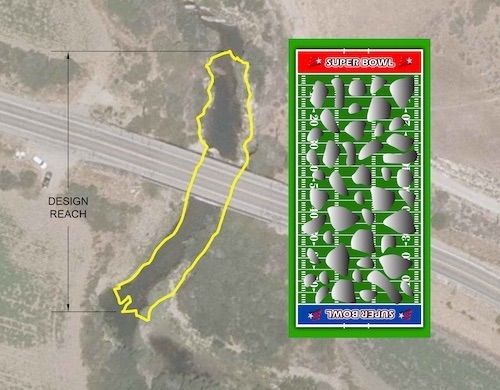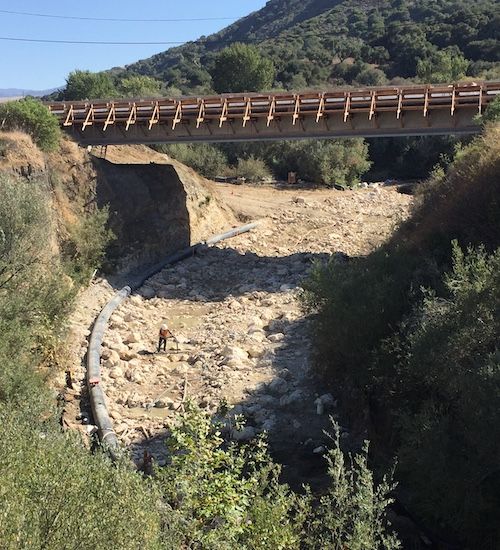Designing passage for humans above and fish below
The Central Coast of California is known for its natural beauty, yet one major problem is a substantial decline in federally endangered Southern California Coast steelhead. Steelhead spend their adult lives in the ocean then return to their natal freshwater streams to spawn. The intended or unintended alteration of these streams by humans has in some cases created barriers to migration for steelhead and other species. Our team of scientists and engineers worked closely with the California Department of Transportation (Caltrans) to create a natural-looking roughened channel to enhance fish passage and promote channel stability.
Challenge
A main barrier to fish passage was the “check dam” constructed on Salsipuedes Creek in Santa Barbara County. It was built back in 1980 to prevent degradation of the channel bed caused by piers associated with the overhead Highway 1 bridge. However, it was only passable by steelhead under a small window of streamflow conditions. In addition, the Highway 1 bridge spanning the creek was in critical condition and in need of repair.
Solution
As part of their bridge replacement project, Caltrans tasked us with creating a new channel design. The design needed to promote fish passage and allow the creek channel to reach a natural state of equilibrium. In order to achieve this, we had to establish variability in habitat and hydraulic conditions conducive to fish passage through construction of multiple types of habitat units (steps, resting pools, and “roughened areas”); floodplain surfaces set at slightly different elevations above the low-flow pathway; and proper transitions to the natural, undisturbed channel at the upstream and downstream ends of the design reach.

Through a rigorous and iterative design process aided by two-dimensional hydraulic modeling, our team—with input from Caltrans and the regulatory agencies (California Department of Fish and Wildlife and National Marine Fisheries Service)—developed a 2.0% sloped, roughened channel, or “rock ramp.”
This design addressed fish passage, channel stability, and transport of sediment and woody debris through the project reach. In order to keep the project from destabilizing over time, the rock ramp required including very large rocks to anchor the newly-constructed stream bed—essentially an entire football field’s worth of boulders.
Results

During the summer of 2020, we joined Caltrans at the construction site and assisted with monitoring the construction of the rock ramp. The first step in the construction process was to excavate all man-made features within the channel and then over-excavate the entire channel to accommodate the new design features. Of primary importance was creation of a stable subsurface with channel-spanning boulder sills supported by concrete buttresses. These underground walls were constructed about every 50 feet and formed stream channel sections that were then filled with a mixture of sand, gravels, cobbles, and boulders known as “engineered streambed material,” or ESM.
Once the entire channel was filled with ESM, additional boulders were clustered together and spaced out over the design reach to form 60 pools that provide habitat complexity and serve as resting spots for migrating fish making their way up the ramp. The design also included a larger pool at the downstream end of the project reach with turtle habitat enhancement features. The final step in the process was to “wash in” fine sediments, a time-consuming process where water was applied with large hoses to settle the finer substrate material into the channel bed to fill any voids in the ESM and create an impermeable surface layer. This process ensures that water remains on the surface of the roughened channel when flows are low between winter storms, and during the summer and fall when rainfall is scarce.
Together, the bridge above and channel below have greatly improved the stream crossing for both humans and steelhead. Southern California Coast steelhead now are able to access the upper watershed of Salsipuedes Creek, which will contribute to the overall species recovery.